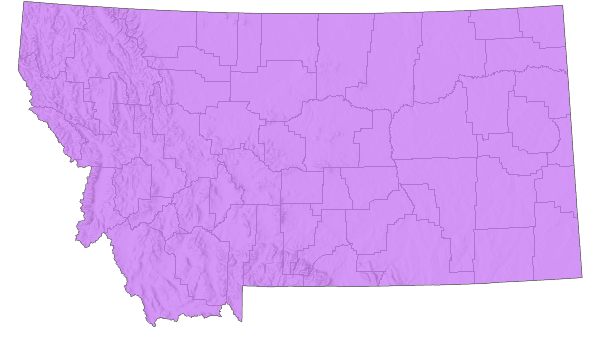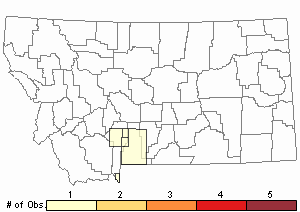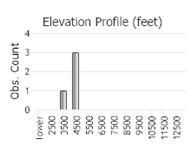View in other NatureServe Network Field Guides
NatureServe
Montana
Utah
Wyoming
Idaho
Wisconsin
British Columbia
South Carolina
Yukon
California
New York
Huckleberry Grasshopper - Melanoplus fasciatus
Other Names:
Huckleberry Spur-throat Grasshopper
General Description
The following is taken from Hebard (1928), Brooks (1958), Helfer (1971), Vickery and Kevan (1985), Capinera et al. (2004), Capinera and Sechrist (1982), and Scott (2010). A small, heavy-bodied grasshopper. It is reddish-brown or grayish-brown dorsally and yellow ventrally. The wings (tegmina) cover three-fourths of the abdomen in males, and two-thirds in females, and sometimes bear dark speckles. Some individuals may occur where the wings extend beyond the abdomen in both males and females. It is a sedentary species and prefers to hide or remain immobile.
Phenology
Adults occur from late June into mid-October. Helfer (1971), Vickery and Kevan (1985), Capinera et al.(2004), Capinera and Sechrist (1982), and Scott (2010).
Diagnostic Characteristics
The following comes from Hebard (1928), Brooks (1958), Helfer (1971), Vickery and Kevan (1985), Capinera et al.(2004), Capinera and Sechrist (1982), and Scott (2010). Adult body length for males 17 to 20 mm, females 20 to 25 mm. The outer surface of hind femur is dull yellowish-brown with two or three angled broad dark bends. The hind tibia is a dull red, lighter at the base, with black spines.
Any number of Melanoplus species can be confused with this species without collecting male specimens for genitalia comparisons to make positive identifications.
Species Range
Montana Range
Range Descriptions

 Native
Native
Range Comments
The following comes from Brooks (1958), Helfer (1971), Vickery and Kevan (1985), Capinera et al.(2004), Capinera and Sechrist (1982), and Scott (2010). The Huckleberry Grasshopper is a northern species, ranging across Canada from Newfoundland to British Columbia and Alaska, southward to about 40 degrees north latitude, but extending farther south to the mountains of Tennessee, Colorado and New Mexico, at altitudes up to 11,000 feet. In Montana, it has been found in 5 counties.
Observations in Montana Natural Heritage Program Database
Number of Observations: 11
(Click on the following maps and charts to see full sized version)
Map Help and Descriptions
Relative Density

Recency



 (Observations spanning multiple months or years are excluded from time charts)
(Observations spanning multiple months or years are excluded from time charts)
Habitat
Prefers open woods and shrub areas, in association with heath plants, Vaccinium, especially open areas with huckleberry and blueberry shrubs. It can also be found under spruce and pine, or on ground-cedar and bearberry. (Brooks 1958, Helfer 1971, Vickery and Kevan 1985, Capinera et al. 2004, and Capinera and Sechrist 1982).
Food Habits
This is a mixed feeder, preferring a variety of forbs (Capinera and Sechrist 1982).
Reproductive Characteristics
In the southern parts of its range, it has a one-year life cycle (egg to adult). In its northern range and at high altitudes, it often requires 2 or more years to develop. Twenty to twenty-nine eggs are arranged in two columns within an egg pod (Capinera and Sechrist 1982).
Stewardship Responsibility
References
- Literature Cited AboveLegend:
 View Online Publication
View Online Publication Brooks, A.R. 1958. Acridoidea of Southern Alberta, Saskatchewan, and Manitoba (Orthoptera). The Canadian Entomologist (Supplement 9) 90:5-92.
Brooks, A.R. 1958. Acridoidea of Southern Alberta, Saskatchewan, and Manitoba (Orthoptera). The Canadian Entomologist (Supplement 9) 90:5-92. Capinera, J.L. and T.S. Sechrist. 1982. Grasshoppers of Colorado: Identification, Biology, and Management. Fort Collins, CO: Colorado State University Experiment Station, Bulletin 584S. 161 p.
Capinera, J.L. and T.S. Sechrist. 1982. Grasshoppers of Colorado: Identification, Biology, and Management. Fort Collins, CO: Colorado State University Experiment Station, Bulletin 584S. 161 p. Capinera, J.L., R.D. Scott, and T.J. Walker. 2004. Field Guide to Grasshoppers, Katydids, and Crickets of the United States. Ithaca, NY. Cornell University Press.
Capinera, J.L., R.D. Scott, and T.J. Walker. 2004. Field Guide to Grasshoppers, Katydids, and Crickets of the United States. Ithaca, NY. Cornell University Press. Hebard, M. 1928. The Orthoptera of Montana. Proceedings of the Academy of Natural Sciences of Philadelphia, Vol. 80:211-306.
Hebard, M. 1928. The Orthoptera of Montana. Proceedings of the Academy of Natural Sciences of Philadelphia, Vol. 80:211-306. Helfer, J.R. 1971. How to Know the Grasshoppers, Crickets, Cockroaches, and Their Allies. Revised edition (out of print), Mineola, NY: Dover Publications.
Helfer, J.R. 1971. How to Know the Grasshoppers, Crickets, Cockroaches, and Their Allies. Revised edition (out of print), Mineola, NY: Dover Publications. Scott, R.D. 2010. Montana Grasshoppers, Katydids, and Crickets A Pictorial Field Guide to the Orthoptera. MagpieMTGraphics, Billings, MT.
Scott, R.D. 2010. Montana Grasshoppers, Katydids, and Crickets A Pictorial Field Guide to the Orthoptera. MagpieMTGraphics, Billings, MT. Vickery, V. R. and D. K. M. Kevan. 1985. The grasshopper, crickets, and related insects of Canada and adjacent regions. Biosystematics Research Institute, Ottawa, Ontario. Publication Number 1777. 918 pp.
Vickery, V. R. and D. K. M. Kevan. 1985. The grasshopper, crickets, and related insects of Canada and adjacent regions. Biosystematics Research Institute, Ottawa, Ontario. Publication Number 1777. 918 pp.
- Additional ReferencesLegend:
 View Online Publication
View Online Publication
Do you know of a citation we're missing? Bland, R.G. 2003. The Orthoptera of Michigan—Biology, Keys, and Descriptions of Grasshoppers, Katydids, and Crickets. East Lansing, MI: Michigan State University Extension, Bulletin E-2815. 221 p.
Bland, R.G. 2003. The Orthoptera of Michigan—Biology, Keys, and Descriptions of Grasshoppers, Katydids, and Crickets. East Lansing, MI: Michigan State University Extension, Bulletin E-2815. 221 p. Kirk, K. and C.R. Bomar. 2005. Guide to the grasshoppers of Wisconsin. Madison, WI: Wisconsin Department of Natural Resources, Bureau of Integrated Science Services PUB-SS-1008. 154 p.
Kirk, K. and C.R. Bomar. 2005. Guide to the grasshoppers of Wisconsin. Madison, WI: Wisconsin Department of Natural Resources, Bureau of Integrated Science Services PUB-SS-1008. 154 p. Wachter, D.H. 1995. The ecology of selected grasshopper species along an elevational gradient. M.Sc. Thesis. Bozeman, Montana: Montana State University. 59 p.
Wachter, D.H. 1995. The ecology of selected grasshopper species along an elevational gradient. M.Sc. Thesis. Bozeman, Montana: Montana State University. 59 p.
- Web Search Engines for Articles on "Huckleberry Grasshopper"
- Additional Sources of Information Related to "Insects"





